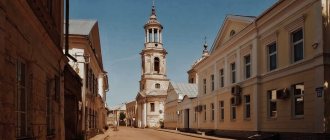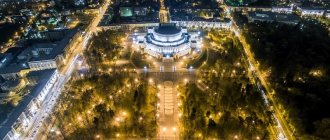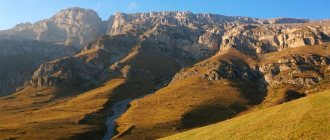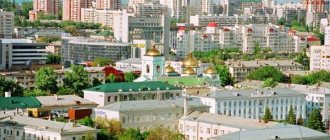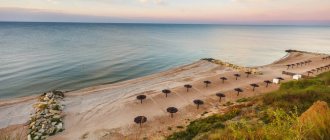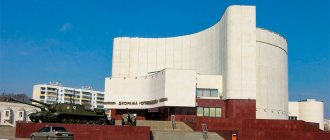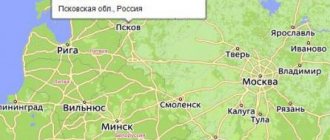| Sights Museums What to see with children Where to go in the evening What to see in the surrounding area Reviews of tourists Where to stay in Pskov Excursions |
Pskov is one of the regional centers of northwestern Russia, a city with more than a thousand years of history. It contains real treasures: temples from the 12th to 15th centuries, ancient chambers and the walls of a huge fortress. The white winter well emphasizes their greatness; under the snow everything is as it was hundreds of years ago.
In winter, the weather in Pskov varies. Temperatures can stay around 0°C or drop to -30°C; winter can be rainless or snowy. When planning a trip, a short forecast is more relevant. In any case, the city is quite comfortable to explore during the cold season: the attractions are compactly located, and museums and cafes are located inside the architectural monuments. It won’t be cold and boring, so what follows is just about what to see in Pskov in winter.
Attractions
Most of Pskov's attractions can be found in the Center district, located on the site of the historical city, within the boundaries of the immense Pskov Fortress. The walk will be fascinating and will open more than one page of history: here are ancient Russian monuments and houses - witnesses of pre-revolutionary times, standards of the Soviet era and, of course, the present reality that cleverly unites them. Many are included in the Pskov Historical, Architectural and Art Museum-Reserve , which includes two dozen of the most valuable objects in the history of the city and its environs.
On Lenin Square Photo: © Sergey Vasilets
Pskovsky Krom
The Pskov Kremlin is undoubtedly the most attractive place for tourists. The silhouettes of ancient walls and towers attract guests, offering to learn about the distant and rich history of the city. They amaze with their power and surprise with the probability of their existence. The monochrome winter weather further emphasizes the impressiveness of the structure. Bright winter sunsets and sunrises add special charm to the landscape.
The Kremlin (Krom) is the heart of the Pskov fortress, the center of its control. It was protected by five fortress walls, the last of which now coincides with Zastennaya and Sverdlova streets. Krom occupies a narrow mountainous cape at the confluence of the Velikaya and Pskov rivers. Historians suggest that the settlement existed here back in the 8th century, and chronicle events mark it from the 10th century. The walls and towers of the fortress were strengthened and rebuilt many times. They saved Pskov and the borders of the state from invasion more than once. The need for them disappeared during the time of Peter I, when the borders of Russia moved closer to Europe. Work to restore the monument has been ongoing since the 1950s. Until now.
Read more: Pskov Kremlin
Pskovsky Krom Photo: © Andrey Panin
Trinity Cathedral
In the center of Krom rises the Trinity Cathedral - one of the tallest in Russia. The time of its initial appearance is unknown for certain, and the one that exists today is its fourth incarnation in 1699. Inside the cathedral is decorated with a seven-tiered iconostasis and shrines with the relics of princes Vsevolod-Gabriel and Dovmont-Timofey are stored.
Read more: Trinity Cathedral
Trinity Cathedral against the backdrop of the zahab - the narrow entrance to the Kremlin Photo: © Andrey Panin
Dovmontov city
Dovmontov city is the second tier of the Pskov fortress, lying at the foot of the Kremlin. It is not possible to pass by it in Krom. It appeared and became an administrative center in the 13th century. under Prince Dovmont-Timofey, from which its name came. In winter, not all the remains of its buildings are clearly visible, however, even covered with caps of snow, they clearly allow you to imagine how 17 churches fit into a small area.
Read more: Dovmontov city
Dovmontov city under the walls of Krom Photo: © vladkonst
Vlasyevskaya Tower
The Vlasyevskaya Tower forms part of the wall on the side of the river south of the Dovmontov city. This is a completely reconstructed part of the Pskov fortress, recreated back in the Soviet years on the basis of the first one. The original one was dismantled in the 1780s as it lost its significance and became dilapidated. Before that, it was one of the most important in the defense of the Kremlin, and also welcomed guests from the west.
The tower tent is two-tiered. There is an observation deck at the top, which offers views of the fortress walls, the Trinity Cathedral, the river and the Holguin Bridge. Inside it there is a small photo exhibition with views of Pskov Krom in past decades.
Read more: Vlasyevskaya Tower
In addition to this tower, the Ploskaya , Vysokaya and Varlaamovskaya towers , including with a guided tour.
Vlasyevskaya Tower Photo: © vladkonst
Ancient temples
A significant contribution to the appearance of Pskov is made by its temples of the 13th–16th centuries, which were not affected by the Mongol invasion. At any time of the year they refer to its originality. Their appearance is distinguished by clear features: a solid whitewashed main part, a wide onion dome holding a drum with traditional ornaments, as well as an unusual belfry - a wall with arches on one of the facades or standing separately next to it.
Due to their uniqueness and preservation, 10 Pskov churches are included in the UNESCO World Heritage List, but they are not the only ones that are impressive. Let’s note those that you will probably come across during your walk, even if you don’t look for them.
Church of St. Basil the Great on Gorka Photo: © DK1974
In the very center of Pskov, and once in the middle and peripheral part of the fortress, there are:
- the Church of St. Basil the Great on Gorka - it is distinguished by the semicircular ends of the quadrangle and numerous chapels, it harmoniously fits into the hill in the park, today called Children's, is included in the UNESCO List, services are held;
- very close to the Church of St. Nicholas the Wonderworker from Usokha - an active temple, a monument of the 16th century;
- The Church of the Intercession and Nativity of the Blessed Virgin Mary from Prolom next to the Intercession Tower is a functioning temple of an unusual appearance: a bell tower unites two symmetrical single-domed churches, one of which was mentioned already at the end of the 14th century.
Church of the Intercession and Nativity of the Blessed Virgin Mary from Prolom Photo: © DK1974
In Zapskovye, not far from Sovetskaya embankment, it is worth finding:
- the Church of Cosmas and Damian from Primostie - a temple of the 15th - 16th centuries, currently in operation, the ensemble includes a fence with a gate, although it is not completely preserved;
- Church of the Resurrection from the Stadishche - located further, dates back to a later time, a striking example of Pskov temple architecture with all the characteristic elements, a four-pillar belfry is installed on the porch;
- next door is the Church of Varlaam Khutynsky ;
- The Church of the Epiphany from Zapskovye is a temple that at one time introduced innovations into the traditions of religious buildings in Pskov: raised arches were covered with an eight-slope roof, and the belfry was located on a separate high wall.
Church of Varlaam Khutynsky Photo: © Andrey Panin
On the left bank of the Velikaya River, in Zavelichye, you should definitely see:
- the Cathedral of the Transfiguration of the Lord in the Spaso-Mirozhsky Monastery - a temple whose appearance is considered to be the 12th century, the main value is the oldest frescoes, similar in type to Byzantine ones and having no analogues in Russia;
- Cathedral of John the Baptist - the church of the former Ivanovo Monastery, today the courtyard of the Krypetsky Monastery, has three helmet-shaped domes, simple in external design, but dates back to the 12th century;
- Church of the Assumption of the Blessed Virgin Mary from Paromenia near the Olginsky Bridge - a temple of the 16th - 19th centuries built and altered, a small detail is crowned with a cross above the dome - a dove.
Church of the Assumption of the Blessed Virgin Mary from Paromegna Photo: © DK1974
In addition, it is worth noting the Cathedral of the Nativity of the Virgin Mary in the Snetogorsky Monastery on Snyatnaya Gora, which is on the northwestern outskirts of the city, on the banks of the Velikaya. In a 14th century temple. original paintings have been preserved - the Dormition of the Mother of God, the Nativity of the Mother of God, the Crucifixion and Resurrection of Christ and other subjects made in Pskov’s own technique.
All churches in Pskov
Monuments
Monuments are an indispensable feature of city streets. While walking around Pskov you will come across monuments dedicated to famous heroes of the past.
An important figure in the history of Pskov was Princess Olga, the first female ruler of Rus' in the mid-10th century. and the first to accept Christianity. It is with her that the founding of Pskov is associated. It began with the Trinity Cathedral on the spot where three rays of the sun fell. Many places in the city are dedicated to her, including two monuments erected for the 1100th anniversary of Pskov in 2003.
The monument to Princess Olga by Zurab Tsereteli depicts her as a warrior with a shield and sword. It is located on the left bank of the city in Riga Park.
Monument to Princess Olga (works by V. Klykov) Photo: © DK1974
The monument to Princess Olga by sculptor Vyacheslav Klykov is more popular since it is located in the city center. The four-meter-tall monument depicts the Holy Equal-to-the-Apostles Princess: her head is crowned with a halo, and she holds a cross in her hands. Nearby is a boy, son Vladimir, holding an icon with the face of Christ and later going down in history as the baptist of Rus'. The pedestal is decorated with bas-reliefs of twelve Christian saints. On Oktyabrskaya Square, where the figure of Olga is facing, the main festive fir tree of Pskov is erected for the New Year.
Behind the monument begins the Children's Park. In it you will find a monument dedicated to the heroes of the Pskov writer V.A. Kaverin, the heroes of the book “Two Captains” - Sanya Grigoriev and Ivan Tatarinov, cult heroes of the Soviet years. The park also has a sculpture “Pskov Skobar” . It stands in honor of all Pskov blacksmiths: according to legend, Peter the Great, who possessed remarkable strength, could not bend the Pskov staple.
Monument to A. S. Pushkin and the peasant woman Photo: © DK1974
Another significant person of the region is A.S. Pushkin. The poet’s family’s native place is located near the regional center in a place called the Pushkin Mountains. In Pskov, on the territory of the Summer Garden, a monument was erected to Pushkin and the peasant woman , in whom his nanny, Arina Rodionovna, is most often seen. In the form of sculpture, it personifies the people, and in general the closeness and unity of the great Russian poet with them.
One of the symbols of Pskov also became the “Battle on the Ice” monument on Mount Sokolikha, which is at the exit from the city towards Gdov. The monument depicts Alexander Nevsky and his squad, who distinguished themselves in April 1242 on Lake Peipus in the fight against the Livonian Order. It stands, of course, not at the site of the battle, but expresses the unity and courage that allowed the Russian people to win.
Monument “Battle on the Ice” Photo: © Sergey Vasilets
About these and other places also in the material:
Sights of Pskov
Sights of Pskov in one day
Monument "Battle on the Ice"
Monument "Battle on the Ice"
The memorial complex in honor of the victory of the Russian army over the Swedes in 1242 was erected in 1968, the authors of the project are architect P. S. Butenko, sculptor I. I. Kozlovsky.
The monument made of bronze and copper depicts the Russian army, which is preparing to go to war against the Swedes. The pedestal is decorated with a bronze plaque “In gratitude to Alexander Nevsky from descendants.”
Address: Pskov district, Mount Sokolikha
Opening hours: daily
Entry: free
Official website: https://pleskov60.ru/pamiatnik-ledovye-poboishche.html
Church of Varlaam Khutynsky on Zvanitsa
Church of Varlaam Khutynsky on Zvanitsa
The temple was first mentioned in chronicles of the 13th century. It was restored and rebuilt several times. This is a typical Russian style temple.
In the temple you can see unique ancient icons of the Pskov school. In the Nikolsky chapel there is a wooden iconostasis of the 17th century of three tiers. On the doors of the iconostasis there are picturesque paintings of the academic school depicting the holy evangelists and the Annunciation.
Address: st. Leona Pozemsky, 53
Working hours: 08:00 – 18:00
The entrance is free
Official website: https://pleskov60.ru/leona-pozemskogo-53.html
Cathedral of the Nativity of John the Baptist of the Ivanovo Monastery
Cathedral of the Nativity of John the Baptist of the Ivanovo Monastery
Until 1925, the cathedral was the main church in the convent of John the Baptist. The temple was built in the mid-12th century from limestone slabs and plinth. It was restored in the 1950s.
In the church you can attend the liturgy and evening service, order a prayer service or memorial service, and also submit requests for commemoration at the Indestructible Psalter. There is a holy spring on the territory of the monastery.
Address: st. Maxim Gorky, 1A
Opening hours: daily, 09:00 – 19:00
Entry: free
Official website: krypetsy.ru
Menshikov Chambers in Pskov
Menshikov Chambers in Pskov
The Menshikov Chambers is a unique monument of Pskov civil architecture of the 17th century. The complex of residential and commercial buildings was built by the head of an ancient merchant family.
There are souvenir shops on the territory of the chambers, where you can buy souvenirs and ceramics. In the museum you can see unique ceramic dishes and attend a master class on working on a pottery wheel.
Address: Sovetskaya, 50
Opening hours: 11:00 – 18:00, Sun and Mon – closed
Entry: free
Official website: https://vk.com/club23464126
Temple of Alexander Nevsky
Temple of Alexander Nevsky
The temple was consecrated in 1908. During Soviet times, a club was located here, and in 1991 the building was returned to the Orthodox Church. Now it is the official temple of the 76th stormtrooper and paratrooper division.
The temple contains a unique icon “The Life of Alexander Nevsky”, which was made by artists from the village of Palekh, Ivanovo region. Divine services are held daily, you can order a prayer service for health or a memorial service.
Address: st. Mirnaya, 1
Working hours: 06:00 – 22:00
The entrance is free
Official website: https://pskov.pobeda.ru/
Museums
Winter is the best time to explore museums, because the weather is usually not very comfortable at this time. The warmth and comfort of city exhibitions will allow you to plunge deeper into the multi-layered history of Pskov and learn many amazing facts.
On the territory of the Kremlin, you should definitely look into the Prikaznye Chambers - an administrative building of the late 17th century, with white limestone, the type of porch and general solidity similar to the architecture of Pskov churches. One of the expositions of the Pskov Museum-Reserve, which is located inside, will tell about its history. In addition, there is also an exhibition “Mr. Pskov”, which will tell about how the medieval city lived and show unique archaeological finds made on its territory. The third exhibition opens the story in the person of A. L. Ordin-Nashchekin, the Pskov governor.
Expositions of the Executive Chambers Photo: © Andrey Panin
From the same time, the Pogankin Chambers , named after the merchant and built according to local architectural principles, have been preserved. They are also part of the museum-reserve; they should soon open after reconstruction as an exhibition site (according to the plan - in 2022).
What to see in Pskov in 1 day, 2 or 3 days
Pogankin chambers Photo: © vladkonst
The neighboring building nearby is the main one in the Pskov Museum-Reserve . Here you can get acquainted with several eras in the history and culture of the city. The exhibition “Culture and Art of Ancient Pskov” is intended to explain the versatility of creativity in different aspects of life. It presents jewelry, dishes, icons and other archaeological finds from the times of paganism and Christianity.
The exhibition “Pskov Region during the Second World War” is dedicated to famous military events of 1941-1945. Located in the very west of the country, Pskov was attacked by the fascist army in early July, and it was occupied for three long years. Exhibits with authentic artifacts tell about military operations in the city and its surroundings, about the life of the population under occupation, about the concentration camp operating nearby, about partisan and underground struggle.
Model of the Pskov Fortress in one of the museums Photo: © Andrey Panin
Postnikov's courtyard - chambers of the 17th century. in Zapskovye, built by the merchant Postnikov. Most of the time they were used for administrative needs; they housed a military unit, a prison, and workshops. Today the walls of the Court have become a museum.
Restoration work took place quite recently, and the exhibitions located there have already pleased the first visitors. Here you can learn more about life in the merchants' chambers, marvel at the variety of ancient crosses, skillful and symbolic, and also see ancient icons, for example, “The Holy Trinity with Selected Saints” from the mid-17th century.
More about what’s interesting on the windows of the city’s museums:
Museums of Pskov
Frescoes in the Transfiguration Cathedral of the Mirozh Monastery Photo: © Andrey Panin
What to see with children
Pskov is not a big city, but nevertheless, you can find entertainment popular among modern children - playrooms with bright toys, trampolines, virtual games clubs. If you really want summer and the opportunity to swim, there is the Aquapolis water park for this. But let us note a more unique leisure activity for families with children who come to winter Pskov.
If you are traveling with a child, you can also start your walk from the Pskov Fortress . Older schoolchildren, who have already mastered the history of Ancient Rus', are more familiar than their parents with all the vicissitudes of the events of past years and have probably heard of Pskov, and Princess Olga, and the Battle of the Ice. A walk under the walls of a real fortress will be a vivid impression and a more attractive activity than reading a textbook.
Within the walls of Pskov Krom Photo: © DK1974
The Pskov Museum-Reserve conducts a large number of interactive educational programs. One of them takes place in the Varlaamov Tower; it will clearly tell you about the history of the fortress and military events.
Most other children's excursions are held in the Postnikov Yard . Young visitors will be told about the customs of tea drinking and main dishes in Rus', the construction and life of villages, stove tiles and linen clothing, trading shops and goods in those ancient times. It is proposed to study the ancient customs through a folk tale.
In addition, a special excursion is organized for ready-made groups in winter, which introduces the history and traditions of celebrating the New Year and the Nativity of Christ, and in February - with the traditional fun of Maslenitsa for the children of Pskov’s past.
Children's program within the walls of the fortress Photo: © Sergey Vasilets
As a cultural program, you can also visit the Pskov Puppet Theater . Young viewers can expect well-known productions such as “The Three Bears” or “The Golden Key”, as well as lesser-known stories that can give new emotions. Closer to the New Year, children are also invited to New Year's performances and musicals at the City Cultural Center and the House of Officers .
Where to go in the evening
As you know, in winter the days are shorter and the evenings are longer, so you also want to spend them no less exciting. In the evening in Pskov you can go for a walk or, after looking at the poster, choose spectacular events for yourself.
An evening walk can be much brighter and more attractive if the day was cloudy and monotonous. Take a walk along the embankments of the Velikaya or Pskova , walk along the central streets and near the Kremlin. The silhouettes of Pskov Krom in the light of lanterns and in the soft glow of the snow are mysterious, halftones and shadows in the landscape create the feeling of a fairy-tale setting.
Photo: © Andrey Panin
If desired, the evening program will be supplemented by performances or concerts from cultural institutions of Pskov. The Drama Theater named after A. S. Pushkin is located in a beautiful building from the beginning of the 20th century. It is a branch of the Alexandrinsky Theater in St. Petersburg, holds theater festivals, often becomes a nominee for the Golden Mask Award and actively tours. The drama theater's repertoire includes works from classics to avant-garde - for every taste.
The Pskov Philharmonic Society occupies the building of the House of Political Education. In the 800-seat hall, world classics and modern compositions are played; listeners are delighted by local musical groups and invited performers, including Russian pop stars.
Pskov Drama Theater Photo: © Andrey Panin
The diversity of the poster of the City Cultural Center on the square. Pobeda, 1 and the House of Officers on the street. Divisional Commander Kirsanova, 5. The stage hosts concerts of vocal and dance ensembles, performances, musicals and festivals. Performances by small groups are also hosted at popular bars in the city.
What to see in the area
When visiting Pskov, at any time of the year, tourists do not miss the opportunity to see the historical cities of Izborsk and Pechory, moreover, the distance to them is only 25 and 40 km, respectively. 120 km south of the regional center there is another famous place - the Pushkin Mountains. It houses the family estate of the poet A.S. Pushkin.
In addition, in the vicinity of Izborsk there is a popular place for recreation and winter outdoor activities - Malskaya Dolina, as well as options for what to see with children.
Oak in Pushkin's Mikhailovsky Photo: © Sergey Vasilets
Malskaya Valley
Malskaya Dolina is a natural landscape park north of Izborsk. On the shore of Lake Malskoe, surrounded by picturesque hills, there is a modern country complex. It offers cozy rooms, a sauna and a restaurant with panoramic views of the beautiful valley.
On the slope facing the lake, there are several ski slopes, equipment rentals and instructor assistance are available. Children will love cheesecake rides, banana rides or snowmobile sleigh rides. In the wonderful winter forest there is a track for classic or skating.
Read more: Malskaya Dolina
Izborsk
Izborsk was once one of the important cities in the north-west of Rus', and today it is a small village visited by thousands of tourists. All thanks to the fact that the fortification of the 30s of the 14th century has been preserved here. — Izborsk fortress . In winter, there are fewer tourists per square meter of the town and fortress, so walking is much more comfortable.
The length of the fortress wall is 623 meters. On the gently sloping western side, the wall is the highest and thickest. Outside, three crosses are embedded in its masonry, as if protecting the village. The seven towers of the fortress have different heights, architecture and purposes. For example, from one of them there is a secret exit hole. You can go into some towers and climb up sections of the walls. Among the few buildings inside the fortress is St. Nicholas Cathedral of the 14th century, built according to the Pskov architectural traditions of that time.
On the wall of the Izborsk fortress Photo: © DK1974
But the city existed before this fortress: less than a kilometer to the north you can see the earthen ramparts of the Truvorov settlement - the first fortification of Izborsk. It existed during the time of the Ruriks. Truvor, the youngest of them, reigned in Izborsk. On the territory of the settlement stands the Church of St. Nicholas of the 17th century.
Another attraction is the Slovenian Springs on the shore of Lake Gorodishchenskoe . These are mineralized springs flowing out of the ground and forming a waterfall. In winter they do not freeze, just like swans and ducks on the lake; they will be happy to have a good treat.
Exhibitions of merchant and peasant life have been opened in the old houses of the town . All remarkable objects of Izborsk are included in the Izborsk Museum-Reserve .
Slovenian springs Photo: © Olga407
Farm "Izborsk Ostrich"
On the way from Pskov to Izborsk there is a farm breeding African ostriches. This is definitely worth a look if you are traveling with a child. In addition to huge birds that don’t mind either frost or predators, here you can see and feed poultry, sheep and rabbits, and buy unusual ostrich products.
Read more: Izborsk Ostrich Farm
Inhabitants of Lake Gorodets Photo: © DK1974
Pechory
Pechory is famous for its Pskov-Pechersky Monastery . There is no exact information about its appearance; more often the story begins with the discovery of “God-created caves” at the end of the 13th - beginning of the 14th centuries. The first nearby was the Assumption Cave Church , and others appeared in subsequent years. Due to its position on the northwestern borders of the country, the monastery acquired a fortress wall. Its history remembers more than one ruin and incredible rescue.
The unusual monastery with caves attracts many tourists. It is worth knowing that you need to sign up for an excursion to the “God-Created Caves” at least several days in advance. You can always visit the territory of the monastery, as well as the exhibition “Ancient storage of the era of Ivan the Terrible” in the Sacristy and the Museum of the Elders in the cave cells of St. Simeon and Archimandrite Seraphim. In the city itself, notable features are the city museum and the water tower with a power plant - an architectural monument of the first half of the 20th century, made of brick and similar in design to a small high-rise building.
Pskov-Pechersky Monastery Photo: © Sergey Vasilets
Mikhailovskoye Museum-Reserve
In the vicinity of the village of Pushkin Mountains there is the family estate of A. S. Pushkin Mikhailovskoye , as well as Petrovskoye , the estate of the Hannibal ancestors, and Trigorskoye - the house of his friends Osipov-Wulfs and, it is believed, the prototype of the Larins' house from Eugene Onegin. Fans of the poet’s work come here to see the picturesque landscapes of the Russian hinterland that inspired the poet, to feel the regularity of winter estate life and to walk through the snow-covered parks.
A significant part of the original buildings of the estates was lost after the revolution of 1918 and during the Second World War of 1941-1945, but after that they were restored for a long time and painstakingly. In the buildings of the three estates there are exhibitions dedicated to different aspects of the work and life of the writer, his family and friends. The tiny village of Bugrovo hosts many interactive programs typical of the Russian culture of the past. On the territory of the Assumption Svyatogorsk Monastery in the Pushkin Mountains there is the poet’s grave.
Read more: Pushkinsky Nature Reserve
Assumption Cathedral in the Svyatogorsk Monastery of the Pushkin Mountains Photo: © Sergey Vasilets
The best attractions in the vicinity of Pskov:
Smolinskoe Lake
Smolinskoe Lake
The flowing lake with clear blue water covers an area of 134 hectares. Its maximum depth is slightly more than 10 meters. A large stream flows into the lake.
The lake is located in the picturesque surroundings of the Pskov region; white swans fly here every year for the summer. The birds are almost tame; local residents and tourists feed them with pleasure. Clean air in the lake area is good for health.
Address: Palkinsky district, Pskov region
Opening hours: daily
The entrance is free
Official website: https://vk.com/wall-191076647_400
Izborsk Fortress
Izborsk Fortress
Izborsk is one of the oldest Russian cities; it was first mentioned in the Tale of Bygone Years. The city fortress was built to protect the Russian state from attacks from the West.
On the territory of the fortress there are several fortified towers - typical examples of medieval fortress architecture. Also here is the Cathedral of St. Nicholas the Wonderworker, built in the 14th century.
Address: Izborsk, Pechorskaya st., 39
Working hours: 10:00 – 18:00
Entrance : 300 rubles
Official website: https://www.museum-izborsk.ru
Truvorovo settlement
Truvorovo settlement
Truvorovo settlement is a historically significant area on the site of an ancient settlement; Subsequently, the city of Izborsk was founded here. First, the Izborsk fortress was built here, and only then it was moved to where it is now.
At the entrance to the site there are remains of ancient graves with limestone stone slabs. Truvor's cross is installed on one of the graves; According to legend, it is here that the ancient Russian prince Truvor from the Varangian family is buried.
Address: Izborsk, Pskov region
Working hours: 10:00 – 20:00
Entrance : 50 rubles
Official website: https://www.museum-izborsk.ru
Pushkin Mountains
Pushkin Mountains
There are several museums dedicated to the life and work of A. S. Pushkin. The architectural and memorial complex is located against the backdrop of picturesque nature.
In the Pushkin Mountains you can visit the museum of A. S. Pushkin and the museum of the famous Russian writer S. Dovlatov, who once worked here as a guide. Those who love active recreation should stay at the Pushkinogorye tourist center.
Address: Pushkinogorye, Pskov region
Opening hours: Wed – Sun, 10:00 – 18:00
Entrance : 100 rubles
Official website: https://pushkinland.ru
Monument to the 6th company
Monument to the 6th company
The memorial complex was erected in honor of the Sixth Company, which died in 2000 while performing a combat mission in Chechnya. Now the Pskov air assault regiment is located in the village of Cherekha.
The monument, built according to the design of the architect A. Tsarik, is a snow-white parachute dome resting on a symbolic mountain peak - a pedestal. On memorial days, local residents lay flowers at the monument.
Address: Cherekha village, Pskov region
Opening hours: daily
The entrance is free
Official website: https://pleskov60.ru/pamiatnik-pogibshim-voinam-desantnikam.html
Museum "Honey Farm"
Museum "Honey Farm"
The museum is located on a working apiary. The current exhibitions tell about beekeeping and the life of a Russian peasant estate in the 20th century. The apiary is located among picturesque nature.
Here you can try and buy honey made at Glazov’s apiary. Tourists can watch the life of bees in a hive through glass and learn what happens to a person after a bee sting, using the example of a guide.
Address: Dubrovka village, Pskov district
Working hours: 10:00 — 18:00
Entrance: 400 rub.
Official website: https://pasekaglazova.ru/
Zapskovye
Zapskovye
Old Zapskovye is an area where the historical buildings of the city have been completely preserved. The area is located across the Pskovaya River, the Trinity (formerly Sovetsky) bridge leads there.
From the Trinity Bridge you can admire the picturesque view of the ancient Pskov Krom, or the Kremlin. On Zvanitsa Street there are several churches built in the characteristic Pskov style of religious architecture, all churches are working.
Address: Staroye Zapskovye microdistrict
Opening hours: daily
The entrance is free
Official website: https://kraeved1147.ru/pskov-4/
Reviews from tourists
For some tourists, Pskov becomes an amazing discovery that was very close. Someone looks into the city along the way, making it part of a larger journey. Winter weather does not become an obstacle for guests to get acquainted.
Website users shared their thoughts about what they saw on the streets of winter Pskov:
- Dmitry in the stories with photos “Pskov Auto Voyage - Day 3: from Pskov to Smolensk” and “Pskov Auto Voyage - Day 2: “Island, Izborsk, Pechory”;
- Sergey Vasilets in the material “Pskov region - an idea for the weekend”;
- Konstantin with comments and many photos in the photo album “Pskov”.
All tourist reviews about Pskov on Tourister. RU
History, city transport, weather and other points necessary for organizing a trip:
- City guide
- What to bring from Pskov
Pskov embankment Photo: © vladkonst
Best hotels in Pskov
Related materials:
- 29 best attractions in Orel,…
- 33 attractions of Bakhchisaray that are worth visiting
- 43 best attractions in Minsk,…
- 24 must-see attractions in Cappadocia
- 31 attractions of Novorossiysk to visit
- 26 attractions of Svetlogorsk that…
- 25 sights of Olenevka that are worth seeing
- 36 Izmir attractions recommended for…
- 40 attractions in Limassol that are worth seeing
Did you like the article? Share with friends:
Where to stay in Pskov
For a city of 200 thousand inhabitants, Pskov offers a good selection of housing, since it is in demand as a tourist destination and not only. In winter, the tourist flow is less than in summer, so there should not be any difficulties with choice and accommodation. The most convenient hotels and apartments will be in the Center area, where most of the attractions are located.
- Pskov Hotels
- Hostels for Budget Travelers
- Flats and apartments
Book accommodation only on trusted portals. Cashback will be a bonus on Booking: Cashback promotion for Tourist. RU
Hotels with views of the Pskov Kremlin Photo: © DK1974
Excursions
A guided tour is a good way to organize a trip if you want to spend it intensely or have too little time for it. A local guide knows every corner of his city, he will tell you about the main attractions or show you not popular, but interesting or unusual places.
A standard tour of Pskov certainly includes a tour of the Pskov Fortress , a visit to Krom , towers, and merchant chambers. The churches that are unlikely to go unnoticed are the Trinity Cathedral and the Transfiguration Cathedral of the Mirozh Monastery , which preserves unusually skillful frescoes of the 12th century.
A country excursion to Izborsk and Pechory will be convenient for tourists without a car. In one day you can see the most significant places in the vicinity of Pskov. The small village was previously an important city in Rus'. It began with the Truvorov settlement and continued in the Izborsk fortress , which is where the guest can get acquainted. And people go to Pechory to feel the atmosphere of an incredible shrine - an ancient monastery standing on caves.
All excursions around Pskov on Experts Tourist. RU
Traveling through ancient Russian lands
The sights of Pskov are included in the Russian heritage lists. Beautiful streets with ancient buildings, fortress walls, chambers of famous families and a stylized embankment - we offer a route that will not allow you to miss the most important thing.
If you want to get to Pskov from Moscow, it is best to choose air travel. In 1 hour 20 minutes you will fly to the place, and in another 15 minutes you will find yourself in the center. The airport is located in close proximity to it.
Flights Moscow – Pskov and back – from 2400 rubles*.
View flights
It is more convenient to get from St. Petersburg by Lastochka. Travel time is 3.5 hours.
Railway tickets St. Petersburg - Pskov - from 750 rubles*.
Select train
For accommodation, we have selected several cozy options in different price categories:
Hotel "Transit" - from 1000 rubles per night for two*.
Hotel Edem - from 2400 rubles per night for two*.
Guest house near Pokrovka - from 6,000 rubles per night for two*.

